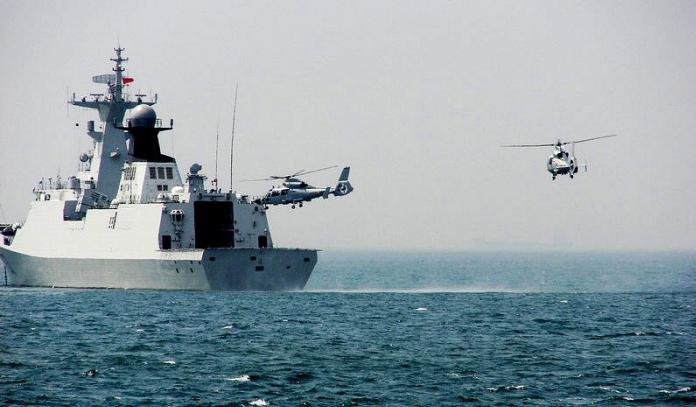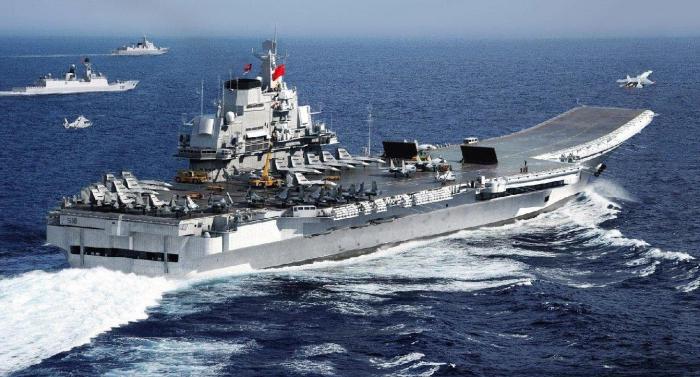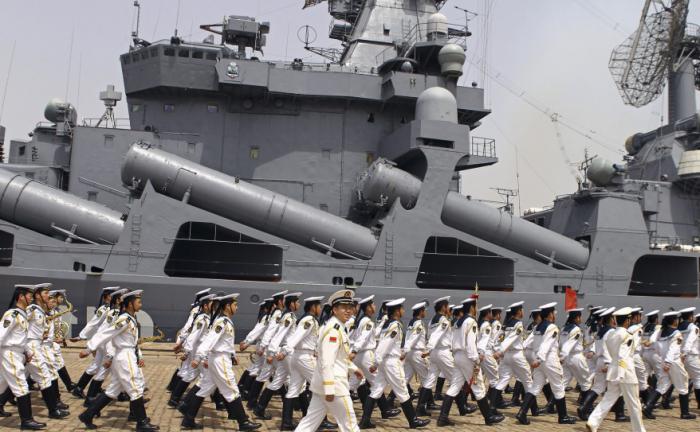The traditions of the Celestial fleet are rooted in ancient times, they are already many centuries and even millennia. But in the modern world, few people are interested in past successes, except for historians. Today, the club of countries with the most powerful naval forces includes China. According to various estimates, the Navy of this country is in third (in some aspects, second) place in the world. In terms of total tonnage, it is second only to the American fleet, but in terms of combat capabilities it lags behind the Russian. He holds confident championship in terms of number of personnel. This is characteristic of all armed forces called the People's Liberation Army of China.
Chinese fleet in the first half of the XX century
Having suffered a defeat from Japan in 1895, the country plunged into a long internecine chaos. The country experienced a period of technical and social backwardness, it was experiencing unrest, uprisings, and therefore could not play the role of a leading sea power in the region. The budget was scarce, the armed forces were technically poorly equipped. In 1909, an attempt was made to modernize: instead of four fleets (Northern, Canton, Shanghai and Fuzhou), there were three of them - Northern, Central and Southern. Each of them included one battleship and several (up to seven) cruisers, which more likely met the standards of gunboats. Reforming, albeit slowly, the management system and infrastructure. Then the government declared its intention to strengthen the Navy and launch dozens of modern ships, but the idea failed, again, for budget reasons. Only three cruisers and destroyers were built. After that, the fleet was replenished only once, when Austro-Hungarian and German ships requisitioned during the First World War accidentally visited China. The Navy of this country practically did not modernize from that time until the end of World War II.
The formation of the fleet of China
In the fact that China had a powerful and modern fleet, not a single country was interested in the post-war world, except for the Soviet Union, which considered the newly formed PRC as its regional ally in Asia. Its first units were obsolete ships inherited from the Naval Forces of the Kuomintang Republic, including the sunk by the Japanese, the lifted and repaired gunboat He Wei. China built the Navy anew, and without external help he could not do. And the Soviet comrades rendered it. Thousands of military advisers, highly qualified and having combat experience, have done everything to grow competent personnel. In the fall of 1949, the Dalian School of Fleet Officers was founded. In addition, a combat shipbuilding program was launched, first based on projects developed in the USSR. After the transfer to Port Arthur to the Chinese side, the PLA turned out to have a huge amount of military equipment, including ships. By the end of the Korean War, Americans were forced to admit that a new leader had emerged in the region - China. The navy of this communist country was still far inferior in combat power to the US fleet based in Hawaii, but in the coastal zone it posed a certain danger.

Organization chart
The fleet structure, adopted back in 1909, was recognized by the Soviet specialists as optimal. It was conditionally divided into three parts: North, South and East with the main basing ports in Qingdao, Zhantyang and Ningbo, respectively. In these cities, administrative structures and headquarters are located. In addition, the fleet command became separate (on the basis of the combat arms), although it was subordinate to the general leadership of the PLA. It was structured by surface, underwater, coastal and aviation directions. The ships of the Navy of China were mainly Soviet-built, so knowledge of the Russian language for the naval officer became mandatory. The imitation of the Soviet military order was also expressed in appearance.
Form and shoulder straps
The Soviet military uniforms of the post-war era, especially the naval ones, were distinguished by some panache, which can even be called old-mode. Gold epaulettes, black tunic and epaulettes with gleams caused nostalgia for pre-revolutionary times and awakened pride in glorious ancestors. Officer insignia of the Navy of China inherited this late Stalinist chic. On uniform, as on the Soviet, there are gaps, the senior officers have two, and the younger one. The location of the stars and their size corresponds to the ranks accepted from the Navy of the USSR from junior lieutenant to admiral. Some national specifics are reserved for the younger ranks. The military ranks of the Chinese Navy differ from the Soviet and Russian due to the peculiarities of transcription, but the general structure of subordination is preserved.
Sailors
The uniform of the naval rank and file of the Navy of the PRC almost completely repeats the Russian one. The same vest, only with a wider upper stripe. Capless caps are also very similar, despite the hieroglyphic inscriptions. It is not known how the pants are fastened: for Russian sailors, from Peter the Great, buttons are traditionally sewn on the sides, where there are pockets on ordinary trousers. Most likely, such subtleties are unknown to Chinese sailors, as well as the meaning of the three stripes on the guise collar. And they are in honor of the three victories of the Russian Navy (Gangut, Chesma, Sinop).
The Chinese sailors are very neat, the uniform sits on them well, the shoes are polished, the copper of the buckles is torn. Everything is like ours. The insignia is somewhat different in the shape of the chevrons.
Activities Minister Comrade Lin Beng
For the most part, Chinese naval officers managed to avoid the destructive processes that swept all of China during the Cultural Revolution. The Navy participated in the suppression of the Wuhan riot of 1967, but on this his role in Maoist crimes was limited. The “Great Leap Forward” did not succeed, and immediately after its unsuccessful ending, through the efforts of Minister of Defense Lin Ben, the modernization of the technical base began. About a fifth of the total military budget was spent on the fleet. During the seventh decade of the 20th century, the number of submarines increased to a hundred (in 1969 there were only 35), the number of missile carriers increased tenfold (there were two hundred). The development of strategic nuclear submarines has begun.
This was an important step in the development of Chinese naval power, but so far it has gone along an extensive path.
Eighties
Commander of the Navy of China Liu Huaqing, who has held his post since 1980, was a close friend of Comrade Deng Xiaoping. He managed to convince the actual head of state that the general direction of the naval strategy should be slightly changed in favor of the quality of modernization of the Chinese Navy. The composition of the numerous warships looked very impressive in appearance, but technically they could hardly compete with American or Soviet modern destroyers and missile cruisers. The educational level of naval commanders should have been improved. The focus of the doctrine had to be turned in a timely manner from passive-coastal activities in favor of operations in open ocean spaces. This requires missiles launched from ships, such as those of the fleets of the USSR and the USA. In 1982, the first launch of an ICBM from a Chinese missile carrier was carried out. In 1984-1985, the ships of the Navy of the PRC paid friendly visits to three neighboring countries. The successes are modest, but progress was evident.

Post-soviet period
In the last decade of the third millennium, processes have occurred in the world that have changed the overall balance of power. If in the days of Mao, China showed expansive aspirations with respect to the USSR, then after its collapse the intensity of the claims practically came to naught. Among the many reasons for the reduction of tension on the eastern borders of Russia, the main one is unprecedented economic growth in China, which has become a "world workshop". A glut of chemical plants threatening to become man-made bombs for densely populated cities, an ever-increasing volume of production and other factors have led to a change in the country's military doctrine .
The Chinese leadership continued to take care of defense, but the emphasis was already on high-tech means that could protect the country, its economy and population from external threats. In addition, the problem of Taiwan and other disputed territories remained urgent.
The unfinished Varyag, an aircraft - carrying cruiser that was no longer claimed by anyone, was inexpensively purchased for the needs of the Chinese fleet. Today he became the first and so far the only aircraft carrier of the Navy of China.
Modern fleet composition
At present, the Chinese Navy is represented by the following units:
Aircraft carriers - 1 (Liaoning, the former Varyag, the largest Chinese ship - its displacement is approximately 60 thousand tons).
Submarine missile carriers - 1 ("Xia", project 092), in the completion or completion of several (at least four) projects "Jin" (094) and "Teng" (096).
Multipurpose nuclear boats - 6 pcs. (projects "Kin", "Han" and "Shan").
Diesel submarines - 68 pcs.
Anti-submarine ships - 116 pcs.
Missile destroyers -26 pcs.
Missile frigates - 49 pcs.
Missile boats - 85 pcs.
Torpedo boats - 9 pcs.
Artillery boats - 117 pcs.
Tank landing ships - 68 pcs.
Hovercraft - 10 pcs.
Radio-controlled raid minesweepers - 4 pcs.
Large bison hovercraft - 2 pcs. (presumably there may be 4).
Plus, more than a thousand aircraft of various types that make up naval aviation.
The total displacement of Chinese ships exceeds 896 thousand tons. For comparison:
Russian Navy - 927 thousand tons.
US Navy - 3, 378 million tons.
Personnel
The governments of the United States and Japan are mainly concerned about the growing power of the Chinese Navy. Photos of ships lined up in a wake column, with frightening comments from time to time, are printed in magazines and published by news sites. But not these samples, for the most part obsolete and inferior to the American ones, serve as the main bugbear. The number that indicates the number of Chinese sailors and military personnel located on coastal bases is very impressive. According to various sources, it is approximately equal to 350 thousand people.
Among them:
Marines - 56.5 thousand
Coastal Forces - 38 thousand
In Naval Aviation, another 34 thousand troops.
This, of course, is a lot. There are far fewer American sailors - there are only 332,000 of them.
Russian and Chinese - brothers forever?
The modern world is designed so that states, defending their interests, are forced to unite and “make friends against” someone who, as a rule, is not alone. A common position on many world problems contributes to the military-political cooperation of the Russian Federation and China. The joint exercises of the Navy of Russia and China in the last year took place in two distant seas - in the Mediterranean and Japan. This demonstration of readiness for mutual assistance and concerted action does not mean that in the event of a military conflict one country will certainly support another through direct intervention. If China wants to regain the island of Taiwan or to tear off part of the territory of Vietnam (which is also Russia's strategic ally in the Southeast Asian region), then it is unlikely that they will receive not only help, but also sympathy from the "Northern Neighbor." Another thing is joint operations at sea against pirates and terrorists. However, China is a peace-loving country, like Russia.

To visit? Welcome!
After the Mediterranean naval maneuvers, the PRC sailors paid a friendly visit to Russian land. The ships of the Chinese Navy in Novorossiysk saluted with twenty-one salvoes, the coastal batteries of the Tsemess bay answered the same.
The sailors of both fleets took part in celebrations dedicated to the 70th anniversary of the victory over German fascism.
The meeting place of the deputy commanders of the Russian Navy (A. Fedotenkov) and China (Du Jinchen) was the 34th pier of the city embankment. The ceremony, despite its officiality, was cordial. Apparently, the Sea Engagement 2015 maneuvers were successful. Probably, these are not the last joint exercises of the Navy of Russia and China.